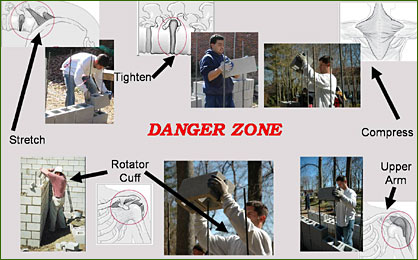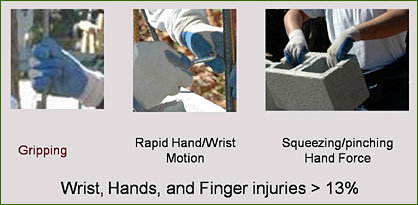January 2009
Safety
Design For Safety
The masonry trade, particularly for block masons, is physically demanding and often dangerous. Workplace injuries take a toll on workers, timelines and overall profitability. New product innovation and the adoption of engineered products and processes relieve many physical demands of the trade, making masons more productive and the profession more attractive to new personnel; and increasing bottom line profits. However, the masonry industry cannot bear the risks of change alone. Safety professionals, architects/designers and the workers compensation insurance industry must lead the effort by specifying “inherently safe” products.
The construction industry has the highest injury incident rate of all industry sectors, with the masonry sub-sector exceeding industry averages. Chronic, cumulative injuries take a toll on the productivity and work life of block masons. Musculoskeletal Disorders (MSD) affect muscles, nerves, tendons, joints, cartilage and spinal discs. MSDs represent 40 percent of reported lost-time injuries. Cumulative Trauma Disorders (CTD) result from chronic or gradual degeneration due to continual exposure to body stresses and strains. Additionally, unreported injuries cost masonry companies lost productivity, absenteeism and loss of trained personnel.
Masons are one of the highest “risk groups” for non-traumatic MSDs of the back, shoulders, arms and legs. They perform four basic movements that expose them to MSDs:
- Bending/stretching

- Handling heavy weights

- Twisting/working in awkward positions

- Exerting gripping/pinching hand force.
?? |
|
| ??Figure 1. Body part graphics from NIOSH Publication 2007-122 |
A significant majority of masonry injuries result from this lifting cycle (See Figure 1). Back and shoulder/upper arm injuries account for almost 50 percent of lost-time injuries. Lifting a heavy block with elbows above the shoulder or hands above the head, bending to lift and holding a block at arm’s length to lower it over rebar contribute to back/shoulder/upper arm injuries. Lifting more than 5 tons per day throughout one’s masonry career builds MSDs into CTDs, which affect masons far into “retirement,” becoming insurance and Medicare health issues.
When handling rebar, workers are exposed to further musculoskeletal injuries. Tying rebar requires gripping, stooping/bending, and rapid hand/wrist motion. The wrists, hands and fingers account for 13 percent of reported masonry lost-time injuries. Gloves help protect the hands, but exacerbate squeezing and finger/thumb pressure issues (See Figure 2). Severe injuries from impalement on rebar also escalate injury costs.
 |
|
| Figure 2. |
The masonry industry is highly competitive. With thin profit margins, there is little financial incentive for masonry contractors to provide more than the minimum safety training, train on new products/processes. or adopt inherently safe products. This sector is dominated by small businesses, 70 percent of which are self-employed masons or firms with 20 or fewer employees. The majority of masons learn their trade on-the-job, learning the “way it has always been done.” Workers may mask injuries to avoid a reputation as being accident prone, due to of fears that reporting injuries could affect employment or immigration status. This cultivates an environment in which MSD/CTD injuries are accepted as the norm. However, the cumulative time lost to injury significantly impacts job costs, cutting into already thin profits.
The University of Oregon has led research to evaluate industry innovations that alleviate bodily stress and injury associated with concrete block construction. Scaffolding, open-ended CMUs, lightweight/AAC Block and two-person lift teams address various aspects of the MDS/CTD issue. The newest innovative product for safer block construction, BARTARGET, significantly reduces injuries associated with lifting block and tying/working around exposed rebar.
While some of these inherently safer new products and methods may have higher upfront costs, they increase the overall profit through productivity gains that easily overcome initial expenses. These savings translate to the masonry contractor through more injury-free days, faster job completion, longer life for skilled masons and a reduction in safety violations and insurance injury claims.
Individual masons and masonry contractors cannot absorb the cost of safer products alone. The masonry industry, architects/designers, safety organizations and the workers compensation insurance industry must pioneer (mandate) the use of safer work products. Safety is too important to be “optional.” Inherently safe work products have the potential to reduce work place injuries beyond what increased oversight and compliance audits can achieve. “Inherently safe” products must be designed and specified for construction projects in a “Design for Construction Safety” approach. Not only will this lead to better working conditions for masons, it will, ultimately, increase bottom line profits in all sectors.
Masonry construction is hard, dangerous and physically demanding. The physical stresses cannot be eliminated. However, with enlightened industry leadership, those stresses can be significantly reduced by institutionally supporting innovation and facilitating the more rapid adoption of inherently safe work products and process changes.